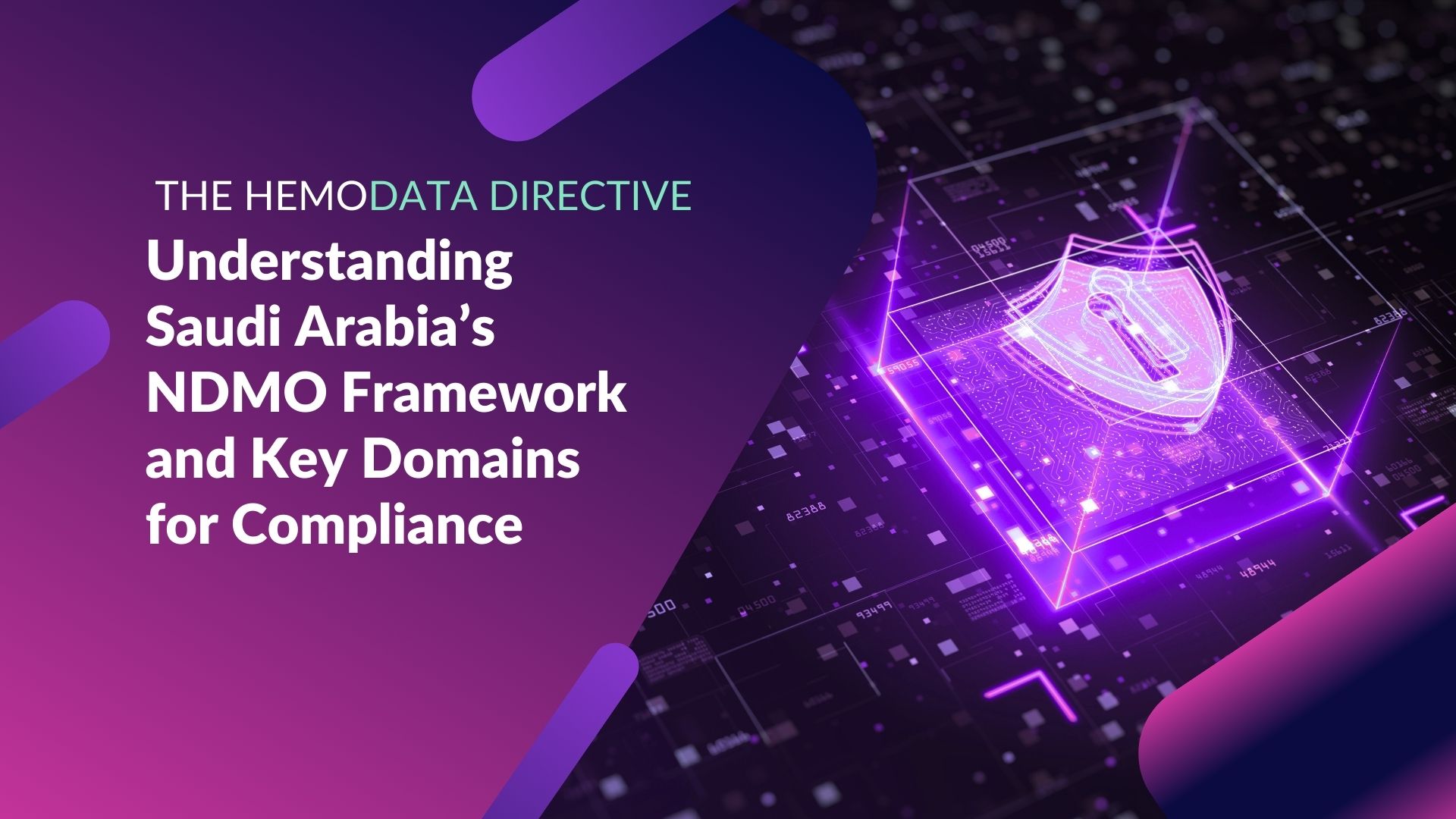The National Data Management Office (NDMO) has set the standard for how data should be governed, secured, and leveraged in Saudi Arabia. For organizations operating in the Kingdom, compliance is a roadmap to building trustworthy, future-ready data practices.
NDMO is mandatory for public companies with private companies adopting compliance for best practice and alignment. PDPL is mandatory for all organizations which we’ve covered in this blog.
This blog breaks down the Guiding Principles at the heart of the NDMO framework and dives into each of the 15 domains that make these principles actionable.
Why the NDMO Framework Matters
Data is no longer just a byproduct of business, it’s one of the most important assets. In an era where AI adoption, cloud migration, and cross-border data flows are accelerating, the NDMO provides a standardized approach to protect, manage, and unlock value from data. Understanding the framework is not just about avoiding fines, it’s about building resilient, interoperable, and ethical data ecosystems.
The Eight Guiding Principles of the NDMO
These principles set the tone for how every organization should approach data governance:
1. Data as a National Asset – Treat data with the same strategic value as infrastructure.
2. Data Protection by Design – Embed privacy and protection measures from day one.
3. Open by Default – Maximize transparency unless there’s a justified restriction.
4. Ethical Data Use – Ensure fairness, accountability, and respect for individuals.
5. Purposeful Design – Collect and process data with clear, defined goals.
6. Data-Driven Outcomes – Make measurable decisions backed by insights.
7. Learning Culture – Encourage ongoing improvement and data literacy.
8. Trusted Data – Build confidence through accuracy, security, and transparency.
These principles guide the practical controls in the 15 domains, which we will dive deeper into within the next section of this blog.
The 15 Domains of the NDMO Framework

Understanding the Domains
| Domain | What It Covers | Why It Matters |
| 1. Data Governance | Policies, ownership, accountability | The backbone of organizational data strategy. |
| 2. Data Catalog & Metadata | Discovery, context, lineage | Makes data searchable, understandable, and traceable. |
| 3. Data Quality | Accuracy, completeness, timeliness | Reliable data fuels better decision-making. |
| 4. Data Operations | Storage, pipelines, availability | Ensures data is accessible, performant, and secure. |
| 5. Document & Content Management | Handling unstructured or legacy content | Keeps organizational knowledge organized and retrievable. |
| 6. Data Architecture & Modelling | Data structures, integration standards | Enables scalability and consistency across systems. |
| 7. Reference & Master Data Management | Shared master records, standard attributes | Prevents duplication and maintains a single source of truth. |
| 8. Business Intelligence & Analytics | Dashboards, reporting, trend analysis | Translates raw data into actionable insight. |
| 9. Data Sharing & Interoperability | APIs, exchange protocols | Enables secure collaboration across departments or agencies. |
| 10. Data Value Realization | ROI tracking, monetization strategies | Connects data use to tangible business outcomes. |
| 11. Open Data | Public datasets, transparency initiatives | Supports innovation and public trust. |
| 12. Freedom of Information | Public access requests | Aligns with transparency laws and citizen rights. |
| 13. Data Classification | Sensitivity levels, asset registers | Guides protection measures based on data type. |
| 14. Personal Data Protection | Consent, privacy, individual rights | Ensures compliance with PDPL and ethical handling. |
| 15. Data Security & Protection | Encryption, access controls, incident response | Protects against breaches and builds resilience. |
Applying the NDMO Framework in Your Organization
NDMO compliance is a lot like maintaining a high-performance sports car.
You can have the best engine, premium fuel, and top-tier design, but if you skip regular maintenance, ignore dashboard warnings, or fail to follow safety rules, the performance drops and risks skyrocket.
For organizations in Saudi Arabia, the National Data Management Office (NDMO) sets the “maintenance manual” for how data should be collected, stored, protected, and used. Its Guiding Principles and 15 data management domains are designed to keep your data engine running smoothly, legally, and securely while also making sure you can accelerate toward business goals without unnecessary risk.
The challenge? Many companies treat NDMO standards as a checklist to tick off once. In reality, just like with a high-performance car, it’s the ongoing tuning, monitoring, and adjustments that keep you compliant and competitive. Here’s how you can stay on top of things:
Assess Domain Maturity
Before you can improve, you need to know where you stand.
- Run a baseline assessment across all 15 NDMO domains to identify strengths and gaps.
- Use maturity models (from “Initial” to “Optimized”) to benchmark your current processes.
- Example: In the Data Quality domain, you may already have basic validation checks but lack ongoing monitoring. Flagging this as “Developing” helps prioritize improvements.
Map Principles to Practices
The NDMO Guiding Principles are the “why,” but your teams need the “how.”
- Translate each principle into tangible business practices. For example, if a principle emphasizes data stewardship, link it to specific activities like periodic access reviews or lineage documentation.
- This ensures that your compliance is both intentional and demonstrable to regulators.
Assign Ownership
Compliance fails when “everyone” owns it, because in practice, no one does.
- Assign a clear Domain Owner for each of the 15 domains, ideally someone with decision-making authority and operational visibility.
- Set success metrics for each owner. In Data Privacy, for example, this could be the percentage of datasets with completed privacy impact assessments.
- Build cross-functional committees so domain owners can share insights and resolve overlaps.
Integrate Tools that Support Compliance
Manual tracking can’t keep up with NDMO’s scope, technology is essential.
- Data Cataloging tools centralize your data inventory and keep it up-to-date.
- Lineage Tracking shows the flow of data from source to consumption, helping identify risks faster.
- Access Management tools ensure only authorized personnel can reach sensitive datasets.
SMEs may be able to manage some compliance activities through manual practices. However, beyond a certain size, this approach quickly becomes unsustainable. Both ensuring compliance and deriving value from your organization’s data becomes nearly impossible without the right enabling tools in place.
That’s why it’s important to integrate tools under an overarching data management strategy rather than treating them as isolated fixes. While multiple categories of tools are often required, discovery, cataloging, lineage, consent management, and IAM, for example, it’s worth starting with cataloging and lineage. These lay the foundation by helping you identify, track, and manage your company’s data across systems.
From there, you can scale into more advanced capabilities (like automation of classification and monitoring), but the key is to ensure all tools are aligned to your broader compliance and data value objectives.[AR4]
Measure, Adapt, and Improve Continuously
Compliance is beyond a “set it and forget it” task.
- Establish a regular review cadence, quarterly or biannually, for each domain’s metrics.
- Use dashboards to visualize progress and pinpoint regression areas.
- Stay agile: when regulations evolve, ensure your internal policies and controls adapt just as quickly.
- Example: If a new directive changes consent requirements, you can update your consent capture processes immediately instead of scrambling during an audit.
Getting aligned with the NDMO framework is about building a foundation for trustworthy, well-governed, and business-ready data. But alignment doesn’t happen in a vacuum. It requires teams, tools, and processes that work together across your organization.
This is where we come in. We don’t just help you interpret and implement NDMO requirements; we also support organizations in achieving PDPL compliance and in developing an overarching data strategy. By combining regulatory alignment with practical data management best practices, we ensure your business is not only compliant but also positioned to unlock the full value of your data.
If you’re ready to operationalize NDMO, strengthen PDPL readiness, and put a clear data strategy into motion, we’d love to help guide you through that journey. Talk to us.




